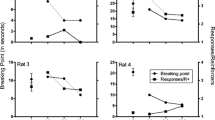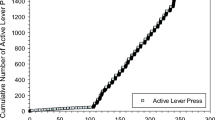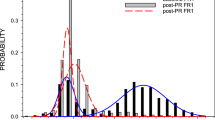Abstract
Rats pressed a lever and obtained food pellets on a schedule of differential reinforcement of low rate (DRL) which required that responses were spaced at least 15 sec apart in order for them to produce reinforcement. When responding had stabilised at slow and steady rates the effects of d-amphetamine and chlordiazepoxide were assessed. Low doses of both drugs increased response rates while higher doses decreased them. Reinforcement frequency showed a dose related decrease after both drugs. When interresponse times (IRTs) were analysed it was found that both drugs shifted the peak of the distribution towards shorter IRTs but that chlordiazepoxide also produced a specific increase in the percentage of responses after very short IRTs (bursts). When IRTs were divided into those following a reinforced response (hit) and those following a non-reinforced response (miss) it was found that bursts normally followed only misses and chlordiazepoxide consistently increased the number of bursts following misses only. Amphetamine did not affect bursts in any consistent way.
Similar content being viewed by others
References
Appel, J. B.: Effects of LSD on time based schedules of reinforcement. Psychopharmacologia (Berl.) 21, 174–186 (1971)
Carey, R. J.: Disruption of timing behaviour following amphetamine withdrawal. Physiol. Psychol. 1, 9–12 (1973)
Carter, D. E., Bruno, L. J. J.: On the discriminative function of the reinforcing stimulus. Psychon. Sci. 11, 21–22 (1968)
Ferraro, D. P., Grilly, D. M., Lynch, W. C.: Effects of marihuana extract on the operant behaviour of chimpanzees. Psychopharmacologia (Berl.) 22, 333–351 (1971)
Fontaine, O., Richelle, M.: Antagonismes des effets centraux et peripheriques de la tremorine par deux parasympathicolytiques l'atropine et la scopolamine. Psychopharmacologia (Berl.) 11, 154–164 (1967)
Gibson, D. A.: Effects of d-amphetamine on multiple schedule performance in the pigeon. Psychon. Sci. 7, 3–4 (1967)
Harzem, P.: Temporal discrimination. In: Animal Discrimination Learning, R. M. Gilbert and N. S. Sutherland, Eds., pp. 299–334. London: Academic Press 1969
Kelleher, R. T., Fry, W., Deegan, J., Cook, L.: Effects of meprobamate on operant behaviour in rats. J. Pharmacol. exp. Ther. 133, 271–280 (1961)
Kornetsky, C.: A comparison of the effects of desipramine and imipramine on two schedules of reinforcement. Neuropharmacol. 4, 13–16 (1965)
Kramer, T. J., Rilling, M.: Differential reinforcement of low rates: a selective critique. Psychol. Bull. 74, 225–254 (1970)
MacDougall, J. M., Van Hoesen, G. W., Mitchell, J. C.: Development of post SR and post non SR DRL performance and its retention following septal lesions in rats. Psychon. Sci. 16, 45–46 (1969).
McMillan, D. E., Campbell, R. J.: Effects of d-amphetamine and chlordiazepoxide on spaced responding in pigeons. J. exp. Anal. Behav. 14, 177–184 (1970)
Millenson, J. R.: A programming language for on-line control of psychological experiments. Behav. Sci. 16, 248–256 (1971)
Morrison, C. F.: A comparison of the effects of nicotine and amphetamine on DRL performance in the rat. Psychopharmacologia (Berl.) 12, 176–180 (1968)
Pradhan, S. N., Dutta, S. N.: Comparative effects of nicotine and amphetamine on timing behaviour in rats. Neuropharmacol. 9, 9–16 (1970)
Pradhan, S. N., Bailey, P. T., Ghosh, P.: Effects of δ 9-tetrahydrocannabinol on a timing behaviour in rats. Psychon. Sci. 27, 179–181 (1972)
Richelle, M.: Temporal regulation of behaviour and inhibition. In: Inhibition and Learning. R. A. Boakes and M. S. Halliday, Eds., pp. 229–251. London: Academic Press 1972
Richelle, M., Xhenseval, B., Fontaine, O., Thone, L.: Action of chlordiazepoxide on two types of temporal conditioning in rats. Int. J. Neuropharmacol. 1, 381–391 (1962)
Schuster, C. R., Zimmermann, J.: Timing behaviour during prolonged treatment with dl-amphetamine. J. exp. Anal. Behav. 4, 327–330 (1961)
Segal, E. F.: Effects of dl-amphetamine under concurrent VI DRL reinforcement. J. exp. Anal. Behav. 5, 105–112 (1962)
Sidman, M.: Technique for assessing the effects of drugs on timing behaviour. Science 122, 925 (1955)
Sidman, M.: Time discrimination and behavioural interaction in a free operant situation. J. comp. physiol. Psychol. 49, 469–473 (1956)
Webster, C. D., Willinsky, M. D., Herring, B. S., Walters, G. C.: Effects of l-δ 1 THC on temporally spaced responding and discriminated Sidman avoidance behaviour in rats. Nature (Lond.) 232, 498 (1971)
Weiss, B., Gott, C. T.: A microanalysis of drug effects on fixed-ratio performance in pigeons. J. Pharmacol. exp. Ther. 180, 189–202 (1972)
Author information
Authors and Affiliations
Rights and permissions
About this article
Cite this article
Sanger, D.J., Key, M. & Blackman, D.E. Differential effects of chlordiazepoxide and d-amphetamine on responding maintained by a DRL schedule of reinforcement. Psychopharmacologia 38, 159–171 (1974). https://doi.org/10.1007/BF00426110
Received:
Revised:
Issue Date:
DOI: https://doi.org/10.1007/BF00426110




